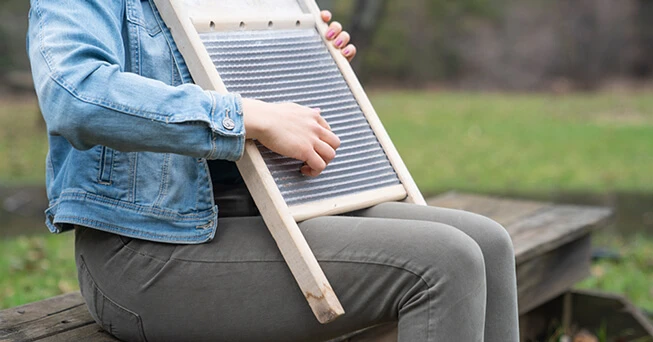How to Play the Washboard as a Musical Instrument

In the musical realm, there are few instruments that capture the historical charm and whimsical percussion of the washboard. This once popular laundry tool was considered effective at removing most dirt and stains from clothing and linens given the right soap and some vigorous scrubbing, but it has since been replaced by the modern convenience of the automatic washing machine. Today these vintage finds are more commonly used to make music, and if you have always wanted to learn how to play the washboard as a musical instrument Mr. Appliance™ can help you get started.
Washboard History
The washboard is a relatively compact instrument that is made from wood, glass, and/or metal, with a ribbed surface. While this surface was ideally suited to scrub clothing, it is equally as effective at making music, with a rich and varied history dating back over one hundred years and spanning the globe.
Jug bands became popular in the 1920s and it is thought that the practice of using the washboard as a percussion instrument originated in West Africa and was introduced to North Americans by African slaves. In 1946 the Zydeco rubboard was invented, eliminating the use of the wood frame and deconstructing the washboard by attaching straps to the metal ribbed surface. This rubboard is also known as a frottoir, and while it only uses a fraction of the original washboard it is much more expensive to buy.
Learn to Play Washboard Instruments
The washboard is an easy instrument to learn and play which can produce a variety of different rhythms and sounds depending on the materials used and the type of movement that is employed. There are four primary ways to position the washboard for use as an instrument:
- Holding it in the crook of the arm.
- Hanging or draping the washboard vertically down the chest with or without the use of straps.
- Laying the washboard vertically across the lap.
- Mounting the washboard on a specially designed stand.
To play the washboard begin by placing metal thimbles on all your fingers and assembling a variety of tools such as a snare brush, whisk broom, wooden spoon, drumsticks, and more.
The 1+2+3+4+ rhythm can be achieved by dragging, tapping, and striking the washboard at timed intervals to create the sound you desire. In a typical four-beat measure, the washboard will be played on the second and fourth beat. Experiment with different sounds by moving your hands down down, up down, down, and up, or develop your own patterns to the beat of the music.
Embellishments and additions may be made to the washboard to customize it, including:
- Bells
- Horns
- Wood blocks
- Tin cans
- And more!
As with any instrument, practice is the key, and while the washboard may seem to be awkward at first it won't be long before you are using it adeptly as an expressive, playful addition to your musical repertoire.
While modern-day washing machines are much easier and more efficient to use than a washboard they may break down from time to time. The team of experienced professionals at Mr. Appliance can get your washing machine up and running in no time with expert appliance repair services. Contact your local Mr. Appliance today to schedule an appointment or call us and let us know how we can help. Plus, we're part of Neighborly, a whole community of home service brands. From plumbing to painting and so much more, check out all the ways they can help you in your home today!


